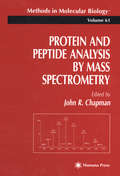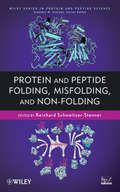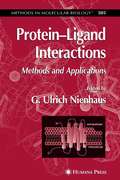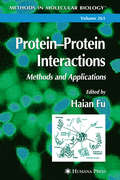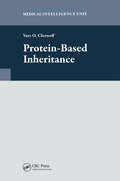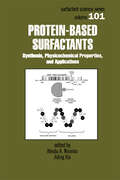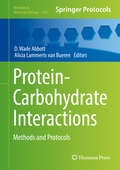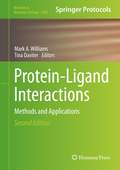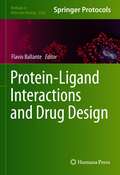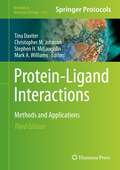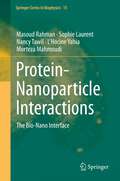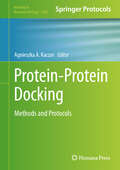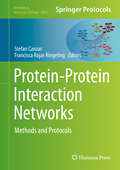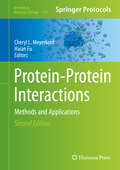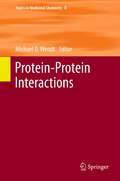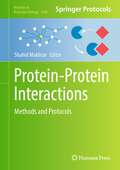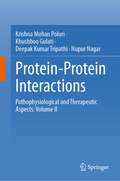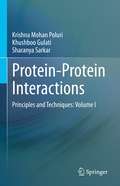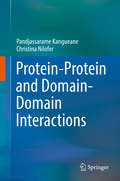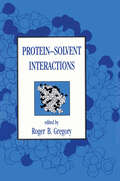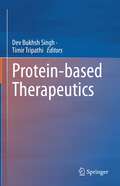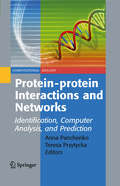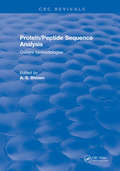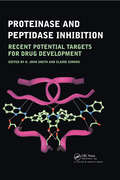- Table View
- List View
Protein and Peptide Analysis by Mass Spectrometry
by John R. ChapmanLeading practitioners authoritatively describe the newest and most effective spectrometric techniques for the analysis of proteins and peptides. The areas covered range from the elucidation of primary and secondary protein structure and the rapid identification of proteins using database techniques to methods for sequencing, as well as methods for the quantitative determination of peptides. Other chapters provide detailed information on the analysis of glycoproteins and glycopeptides and on the use of mass spectrometry to probe the interactions of proteins, both covalent and noncovalent.
Protein and Peptide Folding, Misfolding, and Non-Folding
by Vladimir Uversky Reinhard Schweitzer-StennerSheds new light on intrinsically disordered proteins and peptides, including their role in neurodegenerative diseases With the discovery of intrinsically disordered proteins and peptides (IDPs), researchers realized that proteins do not necessarily adopt a well defined secondary and tertiary structure in order to perform biological functions. In fact, IDPs play biologically relevant roles, acting as inhibitors, scavengers, and even facilitating DNA/RNA-protein interactions. Due to their propensity for self-aggregation and fibril formation, some IDPs are involved in neurodegenerative diseases such as Parkinson's and Alzheimer's. With contributions from leading researchers, this text reviews the most recent studies, encapsulating our understanding of IDPs. The authors explain how the growing body of IDP research is building our knowledge of the folding process, the binding of ligands to receptor molecules, and peptide self-aggregation. Readers will discover a variety of experimental, theoretical, and computational approaches used to better understand the properties and function of IDPs. Moreover, they'll discover the role of IDPs in human disease and as drug targets. Protein and Peptide Folding, Misfolding, and Non-Folding begins with an introduction that explains why research on IDPs has significantly expanded in the past few years. Next, the book is divided into three sections: Conformational Analysis of Unfolded States Disordered Peptides and Molecular Recognition Aggregation of Disordered Peptides Throughout the book, detailed figures help readers understand the structure, properties, and function of IDPs. References at the end of each chapter serve as a gateway to the growing body of literature in the field. With the publication of Protein and Peptide Folding, Misfolding, and Non-Folding, researchers now have a single place to discover IDPs, their diverse biological functions, and the many disciplines that have contributed to our evolving understanding of them.
Protein'Ligand Interactions: Methods and Applications (Methods in Molecular Biology #305)
by G. Ulrich NienhausA readily reproducible collection of established and emerging techniques for studying the interaction between proteins and ligands, including biochemical/bulk techniques, structure analysis, spectroscopy, single-molecule studies, and theoretical/computational tools. Among the highlights are surface plasmon resonance (SPR) and reflectometric biosensor approaches, high-throughput screening with confocal optics microscopy, single molecule fluorescence and fluorescence correlation spectroscopy (FCS), atomic force microscopy (AFM), crystallography of reaction intermediates, and time-resolved x-ray crystallography. The protocols follow the successful Methods in Molecular BiologyTM series format, each offering step-by-step laboratory instructions, an introduction outlining the principle behind the technique, lists of the necessary equipment and reagents, and tips on troubleshooting and avoiding known pitfalls.
Protein'Protein Interactions
by Haian FuA collection of highly successful biochemical, biophysical, genetic, and computational techniques for studying protein-protein interactions. These readily reproducible methods demonstrate how to identify protein interaction partners, qualitatively or quantitatively measure protein-protein interactions in vitro or in vivo, monitor protein-protein interactions as they occur in living cells, and determine interaction interfaces. The techniques described utilize a variety of cutting-edge technologies, including surface plasmon resonance (SRP), fluorescence resonance energy transfer (FRET), fluorescence polarization (FP), isothermal titration calorimetry (ITC), circular dichroism (CD), protein fragment complementation assays (PCA), various two-hybrid systems, and proteomics and bioinformatics-based approaches, such as the Scansite program for computational analysis. These powerful tools are essential for deciphering how proteins interact with each other to form biological networks, as well as for unraveling protein-protein interactions in disease to find novel therapeutic targets.
Protein-Based Inheritance
by Dr. Yury ChernoffThis book covers a topic that has been neglected for years and has returned to the spotlight only recently. Until the genetic role of DNA was firmly established, many researchers suspected that proteins, rather than nucleic acids, could be carriers of heritable information. However, these models were completely forgotten with the triumphal march of the double helix and the development of a central dogma postulating that information flow occurs strictly from DNA, through RNA, to protein, making it seemingly impossible for the proteins to possess a coding potential. Proteins were downgraded to the role of simple perpetuators and executors of DNA orders. Taken together, data included in this book prove beyond a reasonable doubt that proteins and multiprotein complexes are able to control heritable traits, and that, at least in some examples, this control occurs in a template-like fashion, so that new structures strictly reproduce patterns of pre-existing structures that were not specifically coded in DNA. Thus, protein-based inheritance has left the area of speculation and has emerged as a new topic amenable to high-quality experimental analysis.
Protein-Based Surfactants: Synthesis: Physicochemical Properties, and Applications
by Jiding Xia"Describes preparation techniques of protein-based surfactants (PBS) in the laboratory by a variety of chemical and enzymatic means, production by using different types of amino acids, and marketplace applications of PBS in medical and personal care products, detergents, cosmetics, antimicrobial agents, and foods."
Protein-Carbohydrate Interactions
by D. Wade Abbott Alicia Lammerts van BuerenThis volume is a wide-ranging tool for studying protein-carbohydrate interactions that extend from traditional biochemical methods to state-of-the-art techniques. This book focuses on four different research themes: Part I describes methods for screening and quantifying CAZyme activity; Part II contains methods for investigating the interactions between proteins and carbohydrate ligands; Part III discusses methods for the visualization of carbohydrates and protein-carbohydrate complexes; and Part IV focuses on structural and "omic" approaches for studying systems of CAZymes. Written in the highly successful Methods in Molecular Biology series format, chapters include introductions to their respective topics, lists of the necessary materials and reagents, step-by-step, readily reproducible laboratory protocols, and tips on troubleshooting and avoiding known pitfalls. Cutting-edge and thorough, Protein-Carbohydrate Interactions: Methods and Protocols is a valuable resource to the glycomics research community. In this continuously advancing field, the methods in this book highlight the biology of glycomics, thus driving biotechnological innovation and solutions for human health and sustainable resources within the emerging green community.
Protein-Ligand Interactions
by Mark A. Williams Tina DaviterProteins are the cell's workers, their messengers and overseers. In these roles, proteins specifically bind small molecules, nucleic acid and other protein partners. Cellular systems are closely regulated and biologically significant changes in populations of particular protein complexes correspond to very small variations of their thermodynamics or kinetics of reaction. Interfering with the interactions of proteins is the dominant strategy in the development of new pharmaceuticals. Protein Ligand Interactions: Methods and Applications, Second Edition provides a complete introduction to common and emerging procedures for characterizing the interactions of individual proteins. From the initial discovery of natural substrates or potential drug leads, to the detailed quantitative understanding of the mechanism of interaction, all stages of the research process are covered with a focus on those techniques that are, or are anticipated to become, widely accessible and performable with mainstream commercial instrumentation. Written in the highly successful Methods in Molecular Biology series format, chapters contain introductions to their respective topics, lists of the necessary materials and reagents, step-by-step, readily reproducible laboratory protocols, and notes on troubleshooting and avoiding known pitfalls. Authoritative and accessible, Bioinformatics for Omics Data: Methods and Protocols serves as an ideal guide for researchers new to the field of biophysical characterization of protein interactions - whether they are beginning graduate students or experts in allied areas of molecular cell biology, microbiology, pharmacology, medicinal chemistry or structural biology.
Protein-Ligand Interactions and Drug Design (Methods in Molecular Biology #2266)
by Flavio BallanteThis detailed book collects modern and established computer-based methods aimed at addressing the drug discovery challenge from disparate perspectives by exploiting information on ligand-protein recognition. Beginning with methods that allow for the exploration of specific areas of chemical space and the designing of virtual libraries, the volume continues with sections on methods based on docking, quantitative models, and molecular dynamics simulations, which are employed for ligand discovery or development, as well as methods exploiting an ensemble of protein structures for the identification of potential protein targets. Written for the highly successful Methods in Molecular Biology series, chapters include introductions to their respective topics, lists of the necessary materials, step-by-step, readily reproducible laboratory protocols, and tips on troubleshooting and avoiding known pitfalls. Authoritative and cutting-edge, Protein-Ligand Interactions and Drug Design provides detailed practical procedures of solid computer-aided drug design methodologies employed to rationalize and optimize protein-ligand interactions, for experienced researchers and novices alike.
Protein-Ligand Interactions: Methods and Applications (Methods in Molecular Biology #2263)
by Mark A. Williams Tina Daviter Christopher M. Johnson Stephen H. McLaughlinThis third edition provides new and updated chapters detailing a complete introduction to common and emerging procedures for characterizing the interactions of individual proteins with their natural ligands, drugs or other binding partners. Chapters detail natural substrates, potential drug leads, quantitative understanding of the mechanism of interaction, and different techniques. Written in the highly successful Methods in Molecular Biology series format, chapters include introductions to their respective topics, lists of the necessary materials and reagents, step-by-step, readily reproducible laboratory protocols, and tips on troubleshooting and avoiding known pitfalls. Authoritative and accessible, Protein Ligand Interactions: Methods and Applications, Third Edition serves as an ideal guide for researchers new to the field of biophysical characterization of protein interactions.
Protein-Nanoparticle Interactions: The Bio-Nano Interface
by Morteza Mahmoudi Masoud Rahman Nancy Tawil Sophie Laurent L'Hocine YahiaIn recent years, the fabrication of nanomaterials and exploration of their properties have attracted the attention of various scientific disciplines such as biology, physics, chemistry, and engineering. Although nanoparticulate systems are of significant interest in various scientific and technological areas, there is little known about the safety of these nanoscale objects. It has now been established that the surfaces of nanoparticles are immediately covered by biomolecules (e.g. proteins, ions, and enzymes) upon their entrance into a biological medium. This interaction with the biological medium modulates the surface of the nanoparticles, conferring a "biological identity" to their surfaces (referred to as a "corona"), which determines the subsequent cellular/tissue responses. The new interface between the nanoparticles and the biological medium/proteins, called "bio-nano interface," has been very rarely studied in detail to date, though the interest in this topic is rapidly growing. In this book, the importance of the physiochemical characteristics of nanoparticles for the properties of the protein corona is discussed in detail, followed by comprehensive descriptions of the methods for assessing the protein-nanoparticle interactions. The advantages and limitations of available corona evaluation methods (e.g. spectroscopy methods, mass spectrometry, nuclear magnetic resonance, electron microscopy, X-ray crystallography, and differential centrifugal sedimentation) are examined in detail, followed by a discussion of the possibilities for enhancing the current methods and a call for new techniques. Moreover, the advantages and disadvantages of protein-nanoparticle interaction phenomena are explored and discussed, with a focus on the biological impacts.
Protein-Protein Docking: Methods and Protocols (Methods in Molecular Biology #2780)
by Agnieszka A. KaczorThis volume covers a wide array of topics on protein-protein docking ranging from the fundamentals of the method and its recent developments to docking tools and examples of protein-protein docking applications. The chapters in this book are organized into four parts. Part One looks at the fundamentals of protein-protein docking such as rigid and flexible docking, and sampling and scoring in protein-protein docking. Part Two focuses on the latest advancements made in the field such as how the protein backbone flexibility is treated. Part Three explores practical applications of protein-protein docking tools and databases, with emphasis on software for predicting binding free energy of protein-protein complexes and their mutants. Part Four talks about protein-protein docking approaches to different systems, and their challenges and strategies of molecular docking of intrinsically disordered proteins. Written in the highly successful Methods in Molecular Biology series format, chapters include introductions to their respective topics, lists of the necessary materials and reagents, step-by-step, readily reproducible laboratory protocols, and tips on troubleshooting and avoiding known pitfalls. Cutting-edge and thorough, Protein-Protein Docking: Methods and Protocols is a valuable resource for structural biologists, bioinformaticians, molecular modelers, and medicinal chemists looking to learn more about this important field.
Protein-Protein Interaction Networks: Methods and Protocols (Methods in Molecular Biology #2074)
by Stefan Canzar Francisca Rojas RingelingThis volume explores techniques that study interactions between proteins in different species, and combines them with context-specific data, analysis of omics datasets, and assembles individual interactions into higher-order semantic units, i.e., protein complexes and functional modules. The chapters in this book cover computational methods that solve diverse tasks such as the prediction of functional protein-protein interactions; the alignment-based comparison of interaction networks by SANA; using the RaptorX-ComplexContact webserver to predict inter-protein residue-residue contacts; the docking of alternative confirmations of proteins participating in binary interactions and the visually-guided selection of a docking model using COZOID; the detection of novel functional units by KeyPathwayMiner and how PathClass can use such de novo pathways to classify breast cancer subtypes. Written in the highly successful Methods in Molecular Biology series format, chapters include introductions to their respective topics, lists of the necessary hardware- and software, step-by-step, readily reproducible computational protocols, and tips on troubleshooting and avoiding known pitfalls.Cutting-edge and comprehensive, Protein-Protein Interaction Networks: Methods and Protocols is a valuable resource for both novice and expert researchers who are interested in learning more about this evolving field.
Protein-Protein Interactions
by Haian Fu Cheryl L. MeyerkordThe second edition covers a wide range of protein-protein interaction detection topics. Protein-Protein Interactions: Methods and Applications focuses on core technological platforms used to study protein-protein interactions and cutting-edge technologies that reflect recent scientific advances and the emerging focus on therapeutic discovery. Written in the highly successful Methods in Molecular Biology series format, chapters include introductions to their respective topics, lists of necessary materials and reagents, step-by-step laboratory protocols, and tips on troubleshooting and avoiding known pitfalls. These well-detailed protocols describe methods for identifying protein-protein interaction partners, analyzing of protein-protein interactions quantitatively and qualitatively, monitoring protein-protein interactions in live cells, and predicting and determining interaction interfaces. Authoritative and cutting-edge, Protein-Protein Interactions: Methods and Applications, Second Edition is a valuable resource that will enable readers to elucidate the mechanisms of protein-protein interactions, determine the role of these interactions in diverse biological processes, and target protein-protein interactions for therapeutic discovery.
Protein-Protein Interactions
by Michael D. WendtMichael D. Wendt Protein-Protein Interactions as Drug Targets Shaomeng Wang , Yujun Zhao , Denzil Bernard , Angelo Aguilar , Sanjeev Kumar Targeting the MDM2-p53 Protein-Protein Interaction for New Cancer Therapeutics Kurt Deshayes , Jeremy Murray , Domagoj Vucic The Development of Small-Molecule IAP Antagonists for the Treatment of Cancer John F. Kadow , David R. Langley , Nicholas A. Meanwell , Michael A. Walker , Kap-Sun Yeung , Richard Pracitto Protein-Protein Interaction Targets to Inhibit HIV-1 Infection Nicholas A. Meanwell , David R. Langley Inhibitors of Protein-Protein Interactions in Paramyxovirus Fusion - a Focus on Respiratory Syncytial Virus Andrew B. Mahon , Stephen E. Miller , Stephen T. Joy , Paramjit S. Arora Rational Design Strategies for Developing Synthetic Inhibitors of Helical Protein Interfaces Michael D. Wendt The Discovery of Navitoclax, a Bcl-2 Family Inhibitor
Protein-Protein Interactions: Methods and Protocols (Methods in Molecular Biology #2690)
by Shahid MukhtarThis detailed volume provides a comprehensive collection of classic and cutting-edge methods and techniques in mapping protein-protein interactions. The chapters include a variety of in vitro and in vivo experimental methods covering cell biology, biochemistry, and biophysics. In addition, the book also explores in silico methods including sequence-, structure-, and phylogenetic profile-based approaches as well as gene expression and machine learning methods. Written for the highly successful Methods in Molecular Biology series, chapters include introductions to their respective topics, lists of the necessary materials and reagents, step-by-step and readily reproducible laboratory protocols, as well as tips on troubleshooting and avoiding known pitfalls. Authoritative and practical, Protein-Protein Interactions: Methods and Protocols serves as an ideal guide for researchers working in protein science and beyond.
Protein-Protein Interactions: Pathophysiological and Therapeutic Aspects: Volume II
by Krishna Mohan Poluri Khushboo Gulati Deepak Kumar Tripathi Nupur NagarThe second volume of the book-Protein-Protein Interactions (PPIs) provides an overview of various protein-protein interactions (PPIs) that are involved in various human diseases including cancer, neurodegenerative diseases, immune diseases, and inflammation. It summarizes the structure and ligand-based drug designing approaches for the discovery of small molecules that can inhibit PPIs in these diseases. The book discusses different computational and experimental tools that are used to determine the anomalous interactions underlying the diseases. Lastly, it also reviews the classical interactions between pathogens and hosts that are responsible for the pathophysiology of infectious diseases.
Protein-Protein Interactions: Principles and Techniques: Volume I
by Krishna Mohan Poluri Khushboo Gulati Sharanya SarkarThis book provides a comprehensive overview of the fundamental aspects of protein-protein interactions (PPI), including a detailed account of the energetics and thermodynamics involved in these interactions. It also discusses a number of computational and experimental approaches for the prediction of PPI interactions and reviews their principles, advantages, drawbacks, and the recent developments. Further, it offers structural and mechanistic insights into the formation of protein-protein complexes and maps different PPIs into networks to delineate various pathways that operate at the cellular level. Lastly, it describes computational protein-protein docking techniques and discusses their implications for further experimental research. Given its scope, this book is a valuable resource for students, researchers, scientists, entrepreneurs, and medical/healthcare professionals.
Protein-Protein and Domain-Domain Interactions
by Pandjassarame Kangueane Christina NiloferThis book illustrates the importance and significance of the molecular (physical and chemical) and evolutionary (gene fusion) principles of protein-protein and domain-domain interactions towards the understanding of cell division, disease mechanism and target definition in drug discovery. It describes the complex issues associated with this phenomenon using cutting edge advancement in Bioinformatics and Bioinformation Discovery. The chapters provide current information pertaining to the types of protein-protein complexes (homodimers, heterodimers, multimer complexes) in context with various specific and sensitive biological functions. The significance of such complex formation in human biology in the light of molecular evolution is also highlighted using several examples. The chapters also describe recent advancements on the molecular principles of protein-protein interaction with reference to evolution towards target identification in drug discovery. Finally, the book also elucidates a comprehensive yet a representative description of a large number of challenges associated with the molecular interaction of proteins.
Protein-Solvent Interactions
by Roger B. GregoryThis work covers advances in the interactions of proteins with their solvent environment and provides fundamental physical information useful for the application of proteins in biotechnology and industrial processes. It discusses in detail structure, dynamic and thermodynamic aspects of protein hydration, as well as proteins in aqueous and organic solvents as they relate to protein function, stability and folding.
Protein-based Therapeutics
by Dev Bukhsh Singh Timir TripathiThis book provides an overview of the essential characteristics and clinical applications of therapeutic proteins against human diseases, including cancers, immune disorders, infections, and other diseases. It presents the latest advancements in protein engineering techniques for producing desirable therapeutic proteins. The book also covers the strategies used to formulate and deliver systemic therapeutic proteins, approved protein therapeutics and their targets, and pharmacogenetic biomarkers. Further, it discusses challenges associated with the clinical implications of therapeutic proteins, including safety, immunogenicity, protein stability, degradation, and efficacy. It illustrates the development of biosimilar antibodies, optimization strategies for producing biobetter antibodies, and presents fundamental concepts about biosuperior therapeutics. Lastly, it includes a discussion about protein-based vaccines against bacterial and viral infections.
Protein-protein Interactions and Networks
by Anna Panchenko Teresa M. PrzytyckaThe biological interactions of living organisms, and protein-protein interactions in particular, are astonishingly diverse. This comprehensive book provides a broad, thorough and multidisciplinary coverage of its field. It integrates different approaches from bioinformatics, biochemistry, computational analysis and systems biology to offer the reader a comprehensive global view of the diverse data on protein-protein interactions and protein interaction networks.
Protein/Peptide Sequence Analysis: Current Methodologies
by A.S. BhownThis book is an attempt to provide in a single source current state-of-the-art methodologies for protein sequence analysis. It is hoped that these various chapters are presented in such a way that both the newcomer and the established protein chemist will find useful information and directions to new techniques. This book offers a rich array of techniques and methods for sequencing proteins and peptides. It should meet the expectations of investigators in protein chemistry who wish to update their knowledge of sequencing techniques, and of those who wish to reacquaint themselves with the best available current technologies.
Proteinase and Peptidase Inhibition: Recent Potential Targets for Drug Development
by H. John Smith Claire SimonsCellular proteinases and their physiological role in normal and disease states have been the subject of great interest recently. Proteinase and Peptidase Inhibition presents new reports on a wide range of cellular proteinases whose inhibitors may hold the key to the development of new drugs. It deals with enzyme classes, inhibitor types and regulatory mechanisms governing proteinase activity. Target enzymes are fully described and classified by structural similarity, rather than by pharmacological effects. This is a valuable reference for academic and industrial researchers in medicinal chemistry, drug design and development, pharmacology, biochemistry, and molecular and cell biology.
Proteinkinase Inhibitors (Topics in Medicinal Chemistry #36)
by Stefan LauferThis book reviews the principles of design and examples of successful implementation of proteinkinase inhibitors (PKI), and offers a comprehensive and authoritative overview of the history and latest developments in the field. Chapters written by experts from industry and academia cover the function, structure and topology of Proteinkinases, molecular modelling, disclose how to achieve high level of selectivity for kinase inhibitors, and exploit kinase inhibitors for cancer treatment. Particular attention is given to Inhibitors of c-Jun N-terminal kinase 3, and to covalent Janus Kinase 3 Inhibitors. A case study on Receptor Tyrosine Kinases EGFR, VEGFR, PDGFR is also presented in this book.Given its breath, this book will appeal to medicinal chemists, students, researchers and professionals alike.
